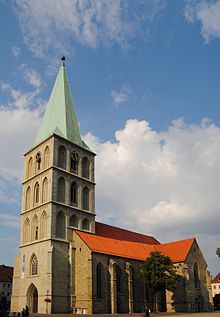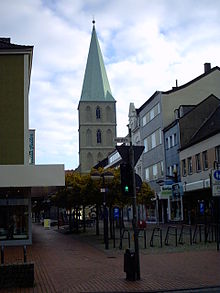Evangelical Paulus Church (Hamm)
The Protestant Pauluskirche is located in the center of the city of Hamm . It has been a listed building since 1985.
History and description of the building
The Protestant Pauluskirche is the central church in Hamm, built in the Gothic style . It is very likely that there was a smaller chapel or similar in the same place before the actual church was built. The exact age of the current structure is unknown; some sources state 1275 as the year construction began. In any case, the construction of the church took place between the founding of the city and the parish. The sacred building was previously called St. George and Laurentius - after the patron saints of the city. A parish was created by parish in 1337 from the Pankratius Church in the village of Mark. In the meantime, the name of the church had also changed. Originally it bore the name of the city's patron saint, St. George, but since the Reformation it has been known as the “Reformed Parish Church”. The name “Great Church” was only officially introduced in 1821 when the Reformed and Lutheran congregations merged. Pauluskirche the building has only been called since 1912.
The Pauluskirche is widely visible in all parts of the city. It is the oldest monumental structure in the city of Hamm. It survived the numerous fires in the Middle Ages and in the 18th century; however, the original structure was heavily attacked. During the reconstruction in 1746 - after the great city fire of 1741 - the late Gothic pointed helmet was replaced by a baroque hood. The hood, which is no longer preserved today, can still be seen on pre-war photos. A far-reaching renovation took place in the years 1893 to 1895. The Pauluskirche was badly damaged in the Second World War . It was restored between 1952 and 1954. In 2006, both the facade and the interior were completely renovated.
The tower of the Pauluskirche has a height of 79.30 meters. It is considered to be one of the most beautiful tower solutions in Westphalia and also an old symbol of the city. The pyramid-shaped spire from 1961 dates back to the period of reconstruction after 1945, which is based on the originally Gothic style of the years before the great city fire of 1741. Since 2007, the tower has been adorned with a new tower clock for the first time in a long time. This represents a new element of the church building that is not in line with the historical state of the church. The ringing of the evening bell at 9 p.m. by the historic bell from 1743 still reminds us of the devastating city fires.
In essence, the building can be traced back to a church that was built soon after the city was founded by Count Adolf I von der Mark on Ash Wednesday in 1226. Significant parts of the choir, the transept and the choir baffle are likely to date from the late 13th century. The tower and the three-aisled nave, however, are dated to the first half of the 14th century.
Furnishing
Three epitaphs (memorial stones) from the 17th and 18th centuries have been preserved in the Pauluskirche. In the south aisle there is a memorial stone made of Baumberger sandstone of a daughter of the Pentlinck (Pentling) family from Münster who died in 1609 . Her name is probably Elisabeth. The memorial stone of Heinrich von Wrede († 1614) in the main nave, which was also made of Baumberger sandstone, is adorned with 16 coats of arms. After the Second World War , the memorial stone of Johannes du Buisson († 1726) was placed in the main nave . He was major general and curator of the Academic Gymnasium. The tombstone of Johann Diedrich von Lemgow (Johan Dietrich von Lemgow) († 1653), which was found when the floor was lowered in the 1950s, was finally walled in on the south wall of the choir. The von Lemgow family provided several Hammer mayors from the 15th to 17th centuries.
organ
The organ , built by the Hamburg organ building company von Beckerath , has been located in the north transept since 1967 and was completely restored and modernized in 2009 by the Beckerath company. The instrument has 39 registers on 3 manuals and a pedal . The Spieltrakturen are mechanically, the Registertrakturen electrically.
|
|
|
|
|||||||||||||||||||||||||||||||||||||||||||||||||||||||||||||||||||||||||||||||||||||||||||||||||||||||||||||||||||||||||||||||||||||||||||||||||||||||||||||||||||||||||||||||||||||||||
- Coupling : I / II, III / II, I / P, II / P, III / P
- Playing aids : 4000 electronic typesetting system , sequencer
Bells
The tower houses six bells. The oldest bell was cast by Johann Schweys in 1743, strike tone c sharp 1 . In 1957, the Bochumer Verein added five cast steel bells, striking a 0 , h 0 , d 1 , e 1 and g 1 .
Parish
The parish, which was connected to the church in the Middle Ages, was created by parish from the church in Mark on April 17, 1337. With the work of Carolus Gallus, the Reformed creed became established in 1562. Gallus had the art objects in the church largely smashed, which explains the simplicity of today's church building. The Reformed community had an elementary school on the market square since the early 17th century. Today the community forms the community district I of the parish of Hamm.
Pastor
- 1664–1690: Bernhard Erasmus Avermann, 1st pastor
- 1721–1743: Johann Heinrich Thienen, 1st pastor
- 1743–1757: Johann Gottfried Peill, 1st pastor
- 1763–1794: Gerhard Rübel, 1st pastor
- 1794: Johann Rulemann Ludwig Eylert , 1st pastor
- 1795–1846: Jakob Wülfingh, 1st pastor
literature
- Friedrich Wilhelm Jerrentrup : Medieval churches in Hamm. In: Georg Eggenstein (Ed.): Zeitspuren. The beginnings of the city of Hamm. Ellen Schwinzer, Bönen 2001, pp. 108–110.
- Andreas von Scheven: Organ in the Pauluskirche with a rich variety of sounds. Restoration work in 2005 gave interesting reviews of forgotten interior designs. In: Unser Westfalen, 2007, p. 78.
- Arnold Torhorst: The old epitaphs in the Pauluskirche in Hamm. In: Yearbook for Westphalian Church History 75, 1982, pp. 185–197.
Web links
Individual evidence
- ↑ More information on the organ of the Pauluskirche ( memento of the original from June 19, 2015 in the Internet Archive ) Info: The archive link was inserted automatically and has not yet been checked. Please check the original and archive link according to the instructions and then remove this notice.
- ↑ Theo Fehn : The bell expert. Bochum cast steel bells . Badenia, Karlsruhe 1997, p. 530.
Coordinates: 51 ° 40 ′ 53 " N , 7 ° 49 ′ 10.6" E


